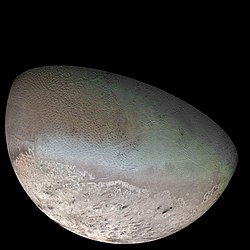Portal:Volcanoes/Selected article/12
Triton (/ˈtraɪtən/, or as in Greek Τρίτων), is the largest moon of the planet Neptune, discovered on October 10, 1846 by William Lassell. It is the only large moon in the Solar System with a retrograde orbit, which is an orbit in the opposite direction to its planet's rotation. At 2,700 km in diameter, it is the seventh-largest moon in the Solar System. Triton comprises more than 99.5% of all the mass known to orbit Neptune, including the planet's rings and twelve other known moons. It is also more massive than all the Solar System's 159 known smaller moons combined.
Because of its retrograde orbit (unique for an object of its size) and similar composition to Pluto, Triton is thought to have been captured from the Kuiper belt. Triton consists of a crust of frozen nitrogen over an icy mantle believed to cover a substantial core of rock and metal. The core makes up two-thirds of its total mass. Triton has a mean density of 2.061 g/cm3 and is composed of approximately 15–35% water ice.
Triton is geologically active; its surface is young and has relatively few impact craters. Although Triton is made of various ices, its subsurface processes are similar to those that produce volcanoes and rift valleys on Earth, but with water and ammonia lavas as opposed to liquid rock. Triton's entire surface is cut by complex valleys and ridges, probably the result of tectonics and icy volcanism.

